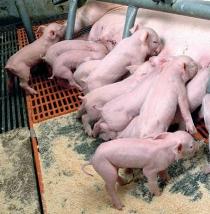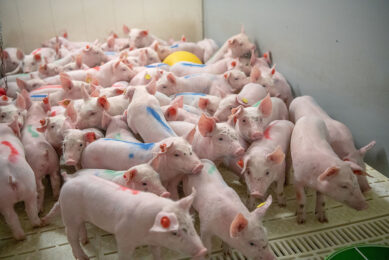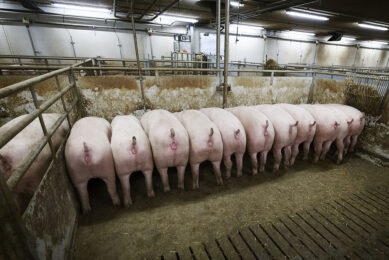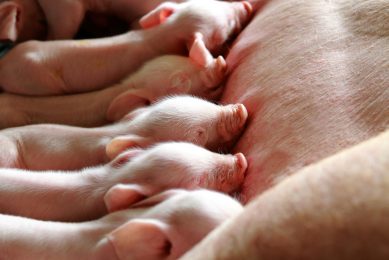Maternally Derived Antibodies: Background, function and importance

‘Maternally Derived Antibodies’ (MDA) is a term which appears in more than one immunological context. These antibodies are induced by both the exposure to natural disease and by the active immunisation of gilts or sows, and can confer passive immunity to newborn piglets. But in doing so, they are also capable of interfering with the piglets’ own immune response to vaccines.
By Alex A.S. Eggen DVM, Intervet/Schering-Plough Animal Health, Boxmeer, the Netherlands
Maternally Derived Antibodies (MDA) can be discussed in relation to several different aspects:
• the immune status of gilts and sows;
• protection transferred to newborn piglets with the ingestion of the first milk (so-called colostrum);
• interference with vaccination programmes in young piglets.
All three different aspects will be treated in this article.
Immune status
On most breeding farms a replacement rate between 30 and 50% of the breeding stock is quite normal, so gilts form the largest single group on a farm. These gilts are often purchased from specialised breeding companies and are selected for their preferred genetic potential. These breeding farms are likely to be ‘cleaner’ than the recipient farms, meaning that it is likely that these new animals harbour fewer pathogens.
The incoming gilts often undergo a period of quarantine on the recipient farm to check their status, and by doing so, they are kept clean. After introduction into the breeding section of the farm, these replacements are routinely kept together as a group, which limits their contact with the resident population of older sows. As a consequence, the exposure of new gilts to the pathogens on the farm takes place either during late gestation or perhaps only when they enter the farrowing crates. From an epidemiological viewpoint, this has major implications for disease control which can vary considerably for different diseases.
For example, when an infection with PRRS or PCV2 virus occurs late in pregnancy, virus will spread from the gilt and will infect the young piglets. These viruses can be shed for long periods by the newly infected gilt which may not necessarily show any clinical signs. Late infections can also lead to major differences in antibody levels between individual gilts, depending on the timing of infection relative to farrowing.
©
An infection in naive gilts with any pathogen can produce high to very high antibody titres, the level reached depending on the agent, its virulence and the infection pressure. The same pathogen often leads to lower titres in the older sow population which has been exposed more frequently and has become immune.
In summary, management practices and the unpredictability of natural infection are the important causal factors of the wide variation in antibody titres in breeding stock in general, and in gilts in particular; the greatest differences occurring between replacement gilts and older sows. The replacement gilts can have lower or higher antibody titres when compared to older sows. Even when the gilts have developed antibodies, they can still be a source of infection for young piglets when infection takes place in naive gilts in late gestation.
Therefore it is very important to study the immunological status of recently purchased gilts, and to harmonise them with the resident breeding stock. Gilt flow management, including a well-designed vaccination programme, is one of the most important aspects of a health programme for breeding stock. The method of choice is to base a gilt vaccination programme on knowledge of the immune status of the incoming gilts, as well as that of the older sows.
This is not necessarily true in combating diseases such as Actinobacillus pleuropneumoniae infections, because vaccination of sows and gilts may interfere with the take of the vaccine in young piglets as explained later. In this case, gilt vaccination during the acclimatisation period against App might be indicated in order to reduce the spread of App by lowering the infection pressure on the piglets, but that is the limit of its usefulness.©©
Protection for newborn piglets
Piglets are born without defense against any pathogen or disease; all the protection they acquire is acquired after birth. The first defensive element a piglet receives is through antibodies passed on by gilts or sows in the colostrum, hence the name Maternally Derived Antibodies.
Not all diseases affect young piglets, and antibodies are not necessarily the principal factor in conferring protection against every disease. But in general, it is true to say that MDA are extremely important in the protection of young piglets against different diseases.
So the rapid ingestion (that means as soon after birth as possible) of a sufficient volume of colostrum containing adequate amounts of the appropriate antibodies is very important to give young piglets a good start, and help them through the first weeks of life. It will also have a great influence on the homogeneity of the litter.
It is generally accepted that with the increasing numbers of sows on breeding farms, and with the increasing cost of labour, less time is likely to be spent attending individual farrowings. More and more is left to the gilts and sows themselves, and Mother Nature. While that might seem to be the ideal scenario, it is surely more realistic, under current intensive systems, to help the process along. For example: appropriate feeding regimes have been devised to optimise colostrum production; the appropriate MDAs with the right type of protective antibodies can be influenced by choosing the right vaccine and the most appropriate vaccination programme; and the comfort and behaviour of sow and piglets can be improved by appropriate temperature control.
Escherichia coli infection in young piglets is a classic example in which infection of the young piglet occurs within seconds after birth, but the protection required can only begin when it has ingested colostrum. When labour constraints mean that newborn piglets are not assisted in receiving the necessary volume (quantity) of colostrum, then the quality of the colostrum, that is colostrum containing high levels of MDAs per ml, becomes really important. Colostrum quality can be influenced by the veterinarian or farmer by their choice of vaccine. Coliform infection is a typical example of a disease of young piglets that does not affect the gilt or sow population. This means that the farmer or the veterinarian cannot judge the MDA status based on clinical observation alone. Vaccination removes any uncertainty.©
Other examples of diseases for which MDAs are particularly important for protecting young piglets are Aujeszky’s, Atrophic Rhinitis and Classical Swine Fever.
©©©©
Vaccination interference
Protection conferred on young piglets is the most beneficial feature of MDAs; interference with vaccine take is very much the downside. Interference is normally detected during R&D trials, when the vaccine response is measured in piglets with varying levels of MDA (so called MDA+ve).
When the vaccine response in MDA+ve piglets is lower than that in MDA-ve piglets, MDA is suspected as having interfered with vaccine take. Interference is not inevitable, it can sometimes be overcome, or even avoided altogether.
When piglets need to be vaccinated at a young age because of the early onset of disease and MDAs are expected to interfere with vaccine take, there are three options to be considered:
1. Trying to keep antibody levels in the gilts or sows low by early vaccination (allowing the antibody titre to reduce to lower levels) or by avoiding infection altogether and in any case not vaccinating the gilts or sows just before farrowing.
2. Postponing piglet vaccination until interference is no longer expected. MDA uptake into the systemic circulation is only possible in the first two days of life. Thereafter MDA levels in the piglets decline, according to the half-life peculiar to each antibody. After a certain interval, the MDA levels are below the specific interference value for that vaccine and vaccination should produce the desired result.
3. Choosing more potent vaccines to break through higher levels of MDA may be the only solution, when management practices on the farm dictate that vaccination must be carried out at a specific age when interference is inevitable.
Several papers have been published, for example on Classical Swine Fever, Aujeszky’s Disease and Influenza, reporting this interference of MDA with vaccine take.
It is still too soon for any firm conclusions to be drawn on the situation with PCV2 virus infections and vaccination, but there are already data suggesting the possibility of interference.
©©©©©©
References available on request
In the context of this paper, only the protection of young piglets through passive immunity is considered. It is, of course, the case that certain pathogens only affect young piglets but that protection is easily and very cost-effectively afforded by vaccinating breeding stock which are normally not affected by the same pathogen.
Source:©Pig Progress Volume 25 nr 2











